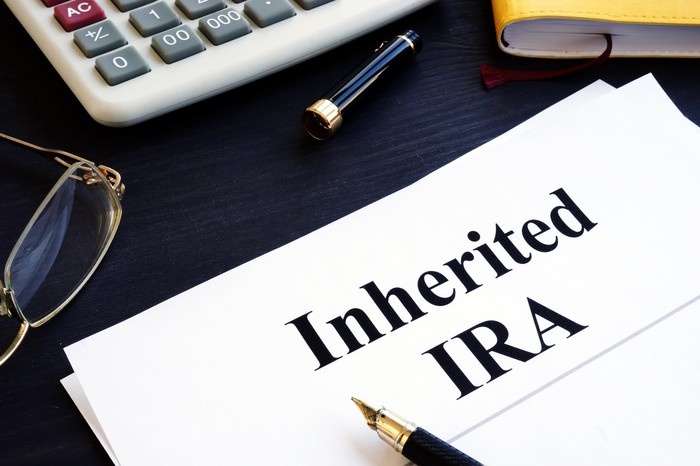When someone dies with money left in an individual retirement account (IRA), the funds usually pass on to the person's loved ones through an inherited IRA. The recipient(s) may spend the funds however they choose, but the government decides how long the money may remain in the inherited account.
The rules governing inherited IRAs are different for spouses and non-spouses. In either case, understanding all your options is crucial to avoid penalties and pay the least in taxes. Here's everything you need to know.

What is an inherited IRA?
An inherited IRA is a tax-advantaged investment account that a person or entity opens to hold the money they've inherited from a deceased loved one's retirement plan. The person opening the inherited IRA, known as the beneficiary, may be the deceased's spouse, child, other relative, friend, or even an estate or trust. If there are multiple beneficiaries, each beneficiary will need to open a separate inherited IRA.
You will owe taxes on withdrawals from your inherited IRA if the funds in the original retirement account were tax-deferred. Distributions from inherited Roth IRAs usually don't increase your taxes, provided the deceased held the Roth account for at least five years. Distributions from Roth IRAs are tax-free because the original owner already paid taxes on the money at the time of their contributions.
How inherited IRAs work
Inherited IRAs, also known as beneficiary IRAs, hold money you inherit from a deceased person's 401(k), IRA, or another retirement plan. You usually have to open an inherited IRA before you can receive any of the funds. Many brokers that offer traditional and Roth IRAs can help you with this.
An inherited IRA stays in your name, but you cannot contribute anything to this account. You're only allowed to make withdrawals -- and you actually have to if you want to avoid trouble with the IRS.
Your withdrawal options depend on your relationship to the deceased and their year of death. The SECURE Act limited the withdrawal options for non-spousal beneficiaries who inherit IRAs after 2019.
Inherited IRA rules for spouses
Spouses have greater flexibility than non-spousal beneficiaries when it comes to inherited IRAs. They can choose to treat the money as their own retirement savings or keep it in an inherited IRA. This gives them greater control over what they pay in taxes on their inheritance and how much money they ultimately receive.
Rolling the inherited funds into their own retirement account enables spouses to avoid required minimum distributions (RMDs) until they turn 73. If the funds originally came from a Roth account, inheriting spouses may be able to leave the money in their own Roth retirement account indefinitely. However, once the money is in the spouse's account, traditional withdrawal rules apply. Taking money out while you're under 59 1/2 usually results in a 10% early withdrawal penalty.
Leaving the money in an inherited IRA is a better option for younger spouses who want to access some of their inheritance before 59 1/2. They'll have the option to take a lump-sum distribution, withdraw all the money by the end of the 10th year after the year of the deceased's death (the end of the fifth year if the deceased died in 2019 or earlier), or take RMDs based on their own life expectancy.
Inherited IRA rules for non-spouses
Non-spouses don't have the option to roll their inherited IRA funds into their own retirement account. Most non-spousal beneficiaries inheriting retirement account funds after 2019 are also unable to take RMDs based on their own life expectancy (discussed below).
The only non-spousal beneficiaries who can use the life expectancy method for inherited IRAs in 2020 and later are:
- Minor children (only until they reach 18)
- Disabled or chronically ill individuals
- A person not more than 10 years younger than the deceased
Those who don't meet one of these criteria will have to use the 10-year method. There's no rule about how much you must take out each year with this option. You just need to make sure everything is out by the end of the 10th year after the year the original account owner died, or you could face a 25% penalty on the amount you failed to withdraw.
Your options for receiving benefits
Here's a breakdown of inherited IRA withdrawal options for spousal and non-spousal beneficiaries.
Spousal beneficiary
Spousal beneficiaries can choose between the following inherited IRA options:
- Roll over the funds to your own retirement account: This enables you to avoid paying taxes on the money in the year of the inheritance and gives the funds more time to remain invested.
- Lump-sum distribution: This will be taxable if the money comes from a tax-deferred retirement account, like a traditional IRA or 401(k).
- Take RMDs based on your life expectancy: You must take mandatory annual withdrawals beginning in the later of the year the deceased would have attained 73 or Dec. 31 of the year following the year of death. You calculate your RMD amount by dividing the inherited IRA balance at the end of the previous year by the distribution period next to your age in the IRS Single Life Expectancy table.
- Withdraw all funds by the end of the 10th year after the year of the original owner's death: There's no mandatory annual withdrawal for this method. Note that you must withdraw all funds by the end of the fifth year after the year of the original owner's death if they died in 2019 or earlier.
- Disclaim the funds: If you don't need the money and don't want the additional taxes the inheritance could bring, you can disclaim the money. It will pass to the deceased's contingent beneficiaries or their estate.
Non-spousal beneficiary
Non-spousal beneficiaries can choose between the following inherited IRA options:
- Lump-sum distribution: This option results in a large influx of cash right away, but it also brings a big tax bill.
- Take RMDs based on your life expectancy: This is only an option if the original account owner died before 2020 or if you are the deceased's minor child, are chronically ill or disabled, or are no more than 10 years younger than the deceased.
- Withdraw all funds by the end of the 10th year following the year of the original owner's death: For pre-2020 inheritances, you must withdraw all funds by the end of the fifth year after the year of the original owner's death.
- Disclaim the funds: As with spouses, you don't have to accept the inherited funds if you don't need them. If you disclaim them, there won't be any tax consequences to you.
Related retirement topics
The bottom line on inherited IRAs
Inherited IRAs can provide a welcome source of income, but it's important to understand how they're taxed and by when the money must be withdrawn to avoid incurring penalties. Review all the withdrawal options available before deciding which one is best for you.


